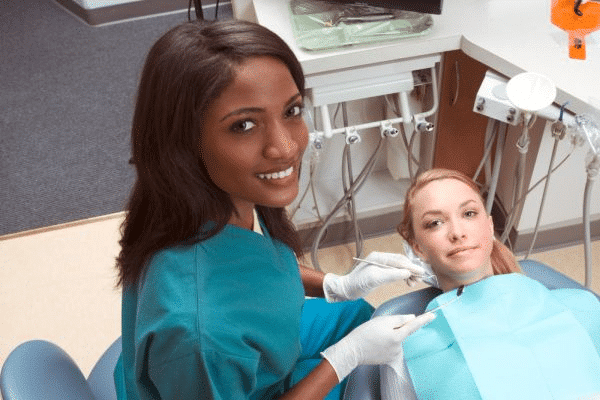Discover Effective Dental Treatments for a Better Smile - Find Out About Dental Bonding
In the search of a glowing smile, individuals typically look for effective dental procedures to improve the look of their teeth. Amongst the different strategies available, oral bonding stands out as a prominent selection for its ability to resolve a range of aesthetic problems. From fixing cracked or discolored teeth to reshaping and shutting spaces enamel, oral bonding uses a functional remedy. Understanding the intricacies of this procedure and its benefits requires a better look at the process, candidacy standards, and post-treatment treatment. By exploring the nuances of dental bonding, one can obtain understandings into how this treatment compares with other alternatives, providing an extensive sight of the opportunities for attaining a brighter smile.
Advantages of Dental Bonding
Oral bonding provides a minimally intrusive and affordable service for enhancing the look of teeth. Unlike various other cosmetic oral treatments, such as crowns or veneers, bonding generally needs minimal to no elimination of the all-natural tooth enamel, making it a conventional choice for smile improvement.
Furthermore, dental bonding is a functional therapy that can attend to a range of visual issues, consisting of closing gaps in between teeth, reshaping misaligned teeth, or making teeth appear longer. The bonding product is adjustable to match the color of your natural teeth, making certain a smooth and natural-looking outcome. Furthermore, bonding is a fairly fast treatment that can typically be finished in one appointment, making it a convenient choice for patients seeking immediate smile improvements.
Treatment Review
Beginning with an evaluation of the procedure associated with dental bonding, we dig right into the thorough introduction of this aesthetic dental procedure. Dentist in Mt Eden. Oral bonding is a minimally invasive method used to improve the appearance of teeth by applying a tooth-colored resin product to the surface. The procedure begins with the dental practitioner choosing a material shade that matches the all-natural shade of the individual's teeth
Following, the tooth surface is roughened, and a conditioning liquid is applied to help the bonding material stick properly. The resin is after that molded and shaped to the preferred type before being set making use of an unique light. When the product has actually set, the dental practitioner will better cut and brighten it to mix seamlessly with the surrounding teeth.
Dental bonding is typically used to fix damaged or broken teeth, close gaps between teeth, improve teeth, and cover discolorations. It is a quick and affordable method to boost the visual appeals of a smile, commonly finished in a solitary check out to the dental practitioner's office.
Candidates for Oral Bonding
When determining eligibility for oral bonding, a detailed exam of the person's dental wellness and aesthetic objectives is carried out. Dental bonding is a versatile cosmetic dentistry treatment ideal for people with small flaws such as cracked, cracked, discolored, or Click This Link twisted teeth. Prospects for oral bonding must have overall good oral health, devoid of gum tissue condition or tooth decay, as these problems might affect the bonding's long life and performance.
Perfect prospects for dental bonding are individuals wanting to enhance the appearance of their smiles without extensive oral job. Dental bonding is a traditional therapy option that can resolve aesthetic problems without the requirement for more intrusive procedures. It is additionally a prominent choice for those looking for quick outcomes, read review as bonding can typically be completed in a single check out to the dental professional's office.

Aftercare Tips
Upon finishing a dental bonding procedure, maintaining appropriate aftercare is necessary to guarantee the long life and performance of the treatment. After the bonding procedure, it is important to prevent consuming difficult foods or biting on objects that could possibly damage the adhered location. In addition, avoiding routines like nail-biting or chewing on pens can help prevent early damage check my site on the bonded material.
Normal dental hygiene techniques, consisting of brushing with a soft-bristled toothbrush and non-abrasive tooth paste, are crucial to protect against and maintain the bond discoloration. It is suggested to floss daily to remove any kind of food bits that may accumulate around the adhered area, reducing the threat of degeneration.
Routine oral examinations every six months are vital to check the condition of the bonding and address any kind of issues promptly. During these visits, your dental professional can assess the bond's stability, make any essential repair work, and provide support on maintaining ideal oral health and wellness to prolong the life-span of the dental bonding.

Comparison With Various Other Therapies
In reviewing dental bonding as a treatment option, it is necessary to consider its benefits and restrictions in contrast to alternate treatments. One typical option to oral bonding is veneers. Veneers are slim coverings of porcelain or composite material that are tailor-made to cover the front surface area of teeth. While veneers are a lot more stain-resistant and sturdy than bonding, they are additionally extra pricey and call for even more preparation of the natural tooth structure.
An additional preferred choice is dental crowns. Crowns are caps that cover the entire tooth and are commonly used for a lot more substantial damage or to improve the look of a twisted tooth. Unlike bonding, crowns are much more durable and can hold up against better biting forces. However, the procedure of getting a crown involves getting rid of more of the natural tooth structure, making it an irreversible treatment.
Ultimately, the option between dental bonding, veneers, or crowns relies on the person's specific requirements, budget, and wanted outcome. Consulting with an oral professional can assist determine one of the most ideal treatment alternative for achieving a brighter and a lot more confident smile.
Final Thought
In conclusion, dental bonding is an efficient treatment for boosting the look of teeth by correcting blemishes such as staining, voids, and chips. Dental bonding offers a hassle-free and cost-efficient solution compared to other more invasive dental procedures.
Furthermore, oral bonding is a functional therapy that can resolve a selection of visual problems, consisting of shutting spaces in between teeth, reshaping misaligned teeth, or making teeth appear longer.Commencing with an evaluation of the process involved in oral bonding, we dive into the thorough review of this aesthetic oral procedure. Candidates for oral bonding need to have overall good oral health and wellness, free of periodontal disease or tooth degeneration, as these problems may impact the bonding's longevity and effectiveness.
Suitable prospects for oral bonding are individuals looking to enhance the look of their smiles without considerable dental work. Oral bonding uses a hassle-free and economical service contrasted to various other more intrusive dental procedures.